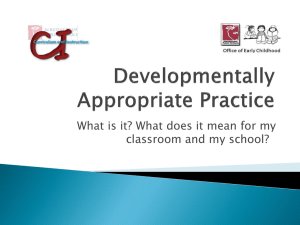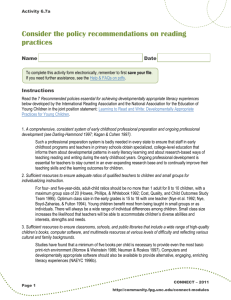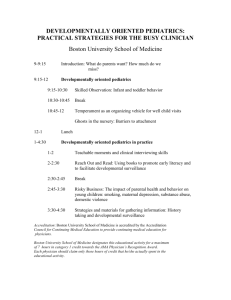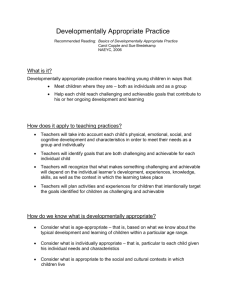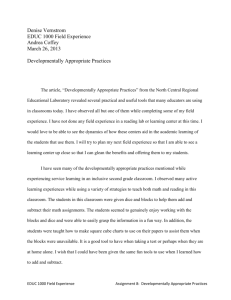Course Syllabus - Arkansas Tech University
advertisement
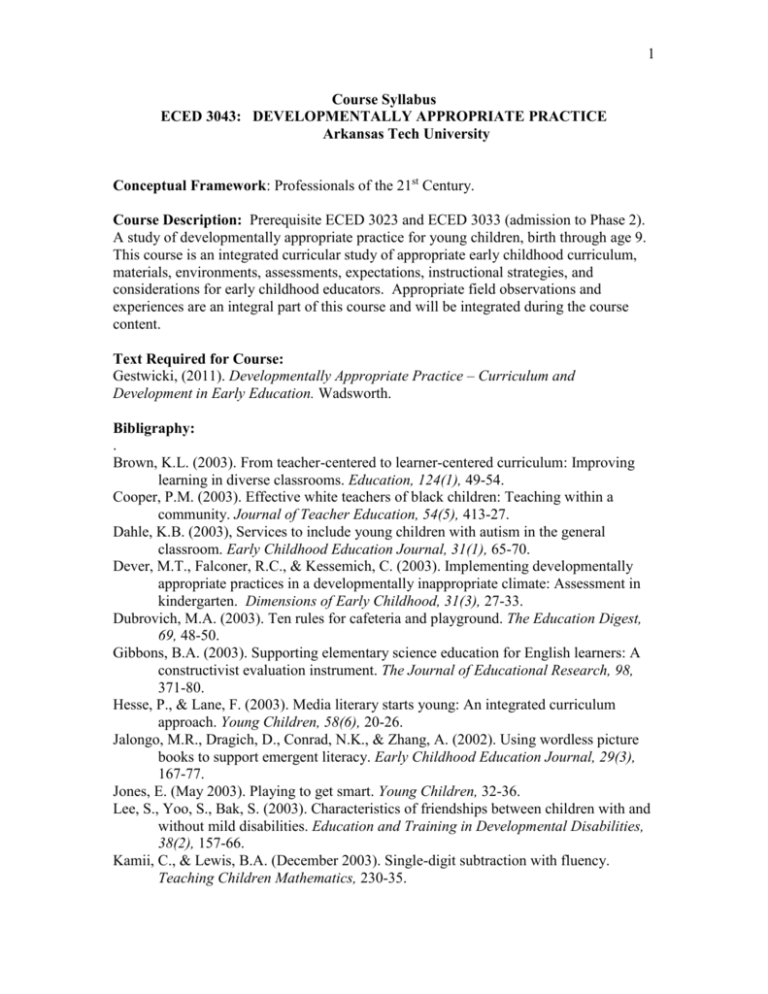
1 Course Syllabus ECED 3043: DEVELOPMENTALLY APPROPRIATE PRACTICE Arkansas Tech University Conceptual Framework: Professionals of the 21st Century. Course Description: Prerequisite ECED 3023 and ECED 3033 (admission to Phase 2). A study of developmentally appropriate practice for young children, birth through age 9. This course is an integrated curricular study of appropriate early childhood curriculum, materials, environments, assessments, expectations, instructional strategies, and considerations for early childhood educators. Appropriate field observations and experiences are an integral part of this course and will be integrated during the course content. Text Required for Course: Gestwicki, (2011). Developmentally Appropriate Practice – Curriculum and Development in Early Education. Wadsworth. Bibligraphy: . Brown, K.L. (2003). From teacher-centered to learner-centered curriculum: Improving learning in diverse classrooms. Education, 124(1), 49-54. Cooper, P.M. (2003). Effective white teachers of black children: Teaching within a community. Journal of Teacher Education, 54(5), 413-27. Dahle, K.B. (2003), Services to include young children with autism in the general classroom. Early Childhood Education Journal, 31(1), 65-70. Dever, M.T., Falconer, R.C., & Kessemich, C. (2003). Implementing developmentally appropriate practices in a developmentally inappropriate climate: Assessment in kindergarten. Dimensions of Early Childhood, 31(3), 27-33. Dubrovich, M.A. (2003). Ten rules for cafeteria and playground. The Education Digest, 69, 48-50. Gibbons, B.A. (2003). Supporting elementary science education for English learners: A constructivist evaluation instrument. The Journal of Educational Research, 98, 371-80. Hesse, P., & Lane, F. (2003). Media literary starts young: An integrated curriculum approach. Young Children, 58(6), 20-26. Jalongo, M.R., Dragich, D., Conrad, N.K., & Zhang, A. (2002). Using wordless picture books to support emergent literacy. Early Childhood Education Journal, 29(3), 167-77. Jones, E. (May 2003). Playing to get smart. Young Children, 32-36. Lee, S., Yoo, S., Bak, S. (2003). Characteristics of friendships between children with and without mild disabilities. Education and Training in Developmental Disabilities, 38(2), 157-66. Kamii, C., & Lewis, B.A. (December 2003). Single-digit subtraction with fluency. Teaching Children Mathematics, 230-35. 2 Morris, D., Bloodgood, J., & Perney, J. (2003). Kindergarten predictors of first- and second-grade reading achievement. The Elementary School Journal, 104(2), 93109. Murata, N.M., & Maeda, J.K. (2002). Structured play for preschoolers with developmental delays. Early Childhood Education Journal, 29(4), 237-40. Neuharth-Prichett, S., Reguerp de Atiles, J., & Park, B. (2003). Using integrated curriculum to connect standards and developmentally appropriate practice. Dimensions of Early Childhood, 3(4), 13-17. Rushton, S., & Larkin, E. (2001). Shaping the learning environment: Connecting developmentally appropriate practices to brain research. Early Childhood Education Journal, 29(1), 25-33. Smith, K., & Wertz, M. (2003). Problem solving and gifted education: A differentiated fifth-grade fantasy unit. Gifted Child Today, 26(3), 56-59. St. Amour, M.J. (2003). Connecting children’s stories to children’s literature: Meeting diversity needs. Early Childhood Education Journal, 31(1), 47-51. Wehmeyer, M.L. (2003). Defining mental retardation and ensuring access to the general curriculum. Education and Training in Developmental Disabilities, 38(3), 271-82. Wesley, P., & Buysse, V. (2003). Making meaning of School readiness in schools and communities. Early Childhood Research Quarterly, 18(3), 351-75. Zucker, S.H. (2003). Comparison of a word study phonics between students with moderate to mild mental retardation and struggling readers without disabilities. Education and Training in Developmental Disabilities, 38(2), 192-99. Additional Requirement: The student will be required to purchase a subscription to TASKSTREAM, an online assessment system to store your artifact. Go to www.taskstream.com for registration information. It is important to register and pay required fees early in the semester. If you have any problems with registration, your university/college technology professional can assist you in this process. Justification/Rationale: Emphasis in this course is on developmentally appropriate practices, environments, instructional strategies, methodologies, and materials for early childhood educators. Teacher candidates will build the competencies necessary to meet state licensure standards and NAEYC guidelines for appropriate practices. Course Objectives: The students will: 1. Use knowledge of how children develop and learn to provide opportunities that support the physical, social, emotional, language, cognitive, and aesthetic development of all young children from birth through age 9. (SS: 2.1.1, 3.1.1, 2.2.1, 3.1.5) (NAEYC: 1a,1b,1c,2a,2b,2c,3a,3b,3c,3d,4b,4c,4d,5a,5b,5d) 2) Use knowledge of how young children differ in their development and approaches to learning to support the development and learning of individual children. (SS: 1.3.6, 2.2.1) (NAEYC: 1a,1b,1c,2a,2b,2c,3a,3b,3c,3d,4b,4c,4d,5a,5b,5d) 3 3) Apply knowledge of cultural and linguistic diversity and the significance of sociocultural and political contexts for development and learning, recognizing that children are best understood in the contexts of family, culture, and society. (SS: 1, 1.2, 1.3.6, 3.2.4) (NAEYC: 1a,1b,1c,2a,2b,2c,3a,3b,3c,3d,4b,4c,4d,5a,5b,5d) 4. Plan and implement developmentally appropriate curriculum goals and instructional practices to include learning centers and child-directed activities and demonstrate developmentally appropriate methodologies for teaching and assessing young children. (SS: 1.1.1, 2.1.1, 2.3.2, 3.1.3, 4.1.1, 4.1.2) (NAEYC: 1a,1b,1c,2a,2b,2c,3a,3b,3c,3d,4b,4c,4d,5a,5b,5d) 5. Use and explain the rationale for developmentally appropriate methods that include play, small group projects, open-ended questioning, group discussion, problem solving, cooperative learning, and inquiry experiences to help young children develop intellectual curiosity, solve problems, and make decisions. (SS: 1.3.5, 2.3.7, 3.3.5) (NAEYC: 1a,1b,1c,2a,2b,2c,3a,4b,4c,4d,5b,5d) 6. Explain the parent/family role and how it is nurtured in a specific early childhood setting. (Ss: 4.33.1, 5.1.6) (NAEYC: 1a,1b,2c,3a,4g,4c,4d,5b,5d) 7. Demonstrate the ability to assess and use various media and instructional technologies in enhancing the classroom environment and curriculum. (SS: 2.1.6, 2.2.3, 2.2.5, 2.3.3, 2.3.8, 3.1.4) (NAEYC: 1a, 1c, 3a, 3b, 3c, 3d, 5a) 8. Recognize developmentally appropriate and inappropriate practices for various ages and stages of children. (SS: 1.3.1, 1.3.2, 3.1.1) (NAEYC: 1a,1b,1c,2a,2b,2c,3a,4a,4b,4c,4d,5b,5d,5e) 9. Demonstrate an understanding of the importance of teachers as advocates for developmentally appropriate curriculum practices. (SS: 5.3.7) (NAEYC: 2a, 2b, 2c, 2a, 2b, 2c, 3a, 3b, 3c, 3d, 4b, 4c, 4d, 5a, 5b, 5c, 5d) 10. Demonstrate how to write clear instructional objectives on various levels of taxonomies. (SS: 2.1.1, 2.1.7, 2.3.1) (NAEYC: 1c) Organizing Theme: The Early Childhood Educator is a life long learner who uses reflective decision making to implement developmentally appropriate practice. Methods of Instruction: A variety of instructional methods in this course may include lectures from the instructor, textbook readings,, powerpoints, small group projects, presentations, and on-line research. In addition, students will be required to complete a field-based observation of children in public schools focusing on inclusion of special students. Assessment Methods: Assessment Methods: A variety of assessment methods will serve to evaluate comprehension and application of the concepts and skills outlined in the course objectives. 4 Assignments: Students will complete the following assignments to demonstrate mastery of the following competencies: 1) Two Objective Examination – 200 points 2) Written Article Review on DAP Instructional Practice – 25 points 3) In-Class – Small Group Learning Center Design and Presentation to class – 100 points 4) ARTIFACT - Learning Center “Individual Student” Narrative Paper (coordinated with rubric) submitted to Taskstream – 100 points 5) Practicum Narrative Paper/Focused Observations – 100 points Point System for Final Grade A= B= C= D= F= 473 to 525 points 421 to 472 points 369 to 420 points 317 to 368 points 316 points and below Grading: Course grades will be based on the accuracy and quality of your work toward the course objectives reflected by the assessment methods. ***Artifact: A developmentally appropriate learning center for a regular education classroom with accommodations and modifications for special learners (with IDEA, the American Disability Act 504, Talented and Gifted, or English Language learners). This artifact will be submitted and saved in the Taskstream ECED Working Portfolio (Assessment: Rubric). This artifact will be submitted to Taskstream. All assignments are expected to be on time. No late assignment will be accepted after one week. Any accepted late assignment will be lowered one grade. All exams need to be taken on the scheduled date. The following regulations apply to exams taken in this class: 1) Any makeup exams will be at the discretion of your instructor. In these cases, the exam must be taken within 1 week of exam given. Students who do not take a missed exam in 1 week will forfeit taking the exam. 2) There will be a deduction on your late exam score for a late exam of one letter grade. DISPOSITION REQUIREMENT *** In addition, in order to make a passing grade (which is a “C” or better in this course), the student must: display a pleasant, respectful and cooperative “teacher disposition” in class, to students, and the professor at all times. 5 NO CELL PHONES OUT OF YORU POCKETS IN CLASS, WHATSOEVER. If one is seen in class by your professor, the student’s cumulative grade will be lowered one grade. NO ASSIGNMENTS (paper or artifact) WILL BE ACCEPTED AFTER THE LAST CLASS of the semester! No exceptions! ATTENDANCE: Punctual and regular attendance is vital to your success in the Arkansas Tech University Early Childhood Program and Arkansas Praxis Scores. Chronic lack of attendance and tardiness will not be tolerated. Although the goal is to be in class EVERY DAY of the semester, you have 4 excused absences. SAVE THEM UP AND USE THEM WISELY! Regardless of your total points earned for this course,… 1) On the 6th absence, your final grade will be lowered one grade. 2) On the 7th absence, your final grade will be lowered one more grade. 3) Automatic failure of the course occurs on the 8th absence. Although we will take roll in class every day, it is your responsibility to be in class and be aware how many absences you have accumulated. Students are to sign ONLY their own name on the role! Any infraction of this will be dealt with severe consequences! ***The professor has the right to use his discretion altering any part of the assessments in this course as deemed necessary and with adequate notice to students. Expectations for Student Behavior – Students are expected to act like adults in class. No whining, talking out of turn or excessive talking, or negotiating anything with the professor will be tolerated. Expectations of Grades – Grades are earned, not given. Getting an A grade is not an inalienable right. THE BUDDY SYSTEM – Although I am assessable to you as your instructor, please form a buddy system in this class. Do not email me asking me what you have missed when you absent in class. Contact your buddy for this information, PLEASE! If you email me and ask, “Dr. Costley, what just happened in class today?” I will most likely reply by saying, “Contact your buddy for this information.” Policy on Cheating and Plagiarism: It is assumed that all students will practice integrity in their studies and submissions with their courses. Please refer to your ATU Student Handbook for the university policy concerning cheating and plagiarism. ***Due to the important content we will be covering this semester, this class is not developmentally appropriate or conducive for children or babies. I respectfully ask that you make alternative appropriate childcare arrangements. 6 Course Content Unit 1 – NAEYC Position Statement: Developmentally Appropriate Practice in Early Childhood Programs Serving Children from Birth Through Age 8 Unit 2 – Developmentally Appropriate Practice: The early Childhood Teacher As Decision Maker Unit 3 – Developmentally Appropriate Practice for Infants and Toddlers Unit 4 – Developmentally Appropriate Practice for 3 to 5 year olds Unit 5 – Developmentally Appropriate Practice for 6 through 8 year olds in the Primary Grades Unit 6 – Steps Toward more Developmentally Appropriate Practice – Helping Teachers Change to More Appropriate Practice Unit 7 – Helping Parents and Communities Understand Developmentally Appropriate Practice Unit 8 – More on Developmentally Appropriate Practice Unit 9 – Defining Developmentally Appropriate Practice: What It Is Not Unit 10 – Results of Developmentally Appropriate Practice Unit 11 – Educational Psychology: A Foundation For Teaching Unit 12 – Theories of Development Unit 13 – Development During Childhood Unit 14 – Behavioral Theories of Learning Unit 15 – The Effective Lesson Unit 16 – Motivating Students to Learn Arkansas Tech University School of Education – Conceptual Framework “Professionals for the Future” 7 Our Vision: Students will become “Professionals for the Future” who will internalize, initiate, and sustain a professional commitment to impact learners in diverse learning communities. Our Mission: The mission of the School of Education at Arkansas Tech University is to positively impact student learning by educating, sustaining, and nurturing professionals who interact within dynamic educational systems through research-, performance,-, and standards-based pre-service and graduate education programs. The Core Values are the context for how professional, state, and institutional standards are addressed within the programs as we prepare Professionals for the Future. The core values direct the development and refinement of the programs, courses, design of instruction, research, service, and assessment. The core values include the following statements of belief. 1) All human beings grow, develop, and learn. 2) Educational processes have key components. 3) Educational practices are systemically coherent and developmentally appropriate. 4) Educators are moral and ethical professionals. 5) Educators focus on maximizing growth, development and learning opportunities for all students. To summarize, the Professionals for the Future is a continuously learning expert(s) with a(n) Strong and developing knowledge of the school culture; Increasing level of professional and pedagogical knowledge, skills, and dispositions; Strong and developing liberal arts background; and Growing expertise concerning systemic and developmentally appropriate practices. These four foundations are unified through the following factors: Diversity Leadership Oral and Written Communication Technology Purposeful Reflection Parents and Community A QUICK OVERVIEW OF PATHWISE Throughout the course, your professor will be referring to the Pathwise Domains. All domains feed into your Praxis II and Praxis III examinations. Domain A has to do with preparation of learning (what happens before the teaching process). Domains B and C have to do with the “teaching process” and “learner outcomes.” Domain D has 8 to do with “Professionalism in Teaching”. Did you make a difference with your teaching? References: Bredekamp, S. & Copple, C. (1997). Developmentally Appropriate Practice in Early Childhood Programs. NAEYC: Washington, D.C. Dever, M.T., Falconer, R.C., & Kessemich, C. (2003). Implementing developmentally Appropriate practices in a developmentally inappropriate climate: Assessments in Kindergarten. Dimensions of Early Childhood, 31(3). 27-33. Murata, N.M., & Maeda, J.K. (2002). Structured play for preschoolers with Developmental delays. Early Childhood Education Journal, 29(4), 237-40. Neuharth-Prichett, S., Reguerp de Atiles, J., & Park, B. (2003). Using integrated Curriculum to connect standards and developmentally appropriate practice. Dimensions of Early Childhood, 3(4), 13-17. St. Amour, M.J. (2003). Connecting children’s stories to children’s literature: Meeting Diversity needs. Early childhood Education Journal, 31(1), 47-51. Wehmeyer, M.L. (2003). Defining mental retardation and ensuring access to the general Curriculum. Education and Training in Developmental Disabilities, 38(3), 27182. Zucker, S.H. (2003). Comparison of a word study phonics between students with moderate to mild mental retardation and struggling readers without disabilities. Education and Training in Developmental Disabilities, 38(2), 192-99.
